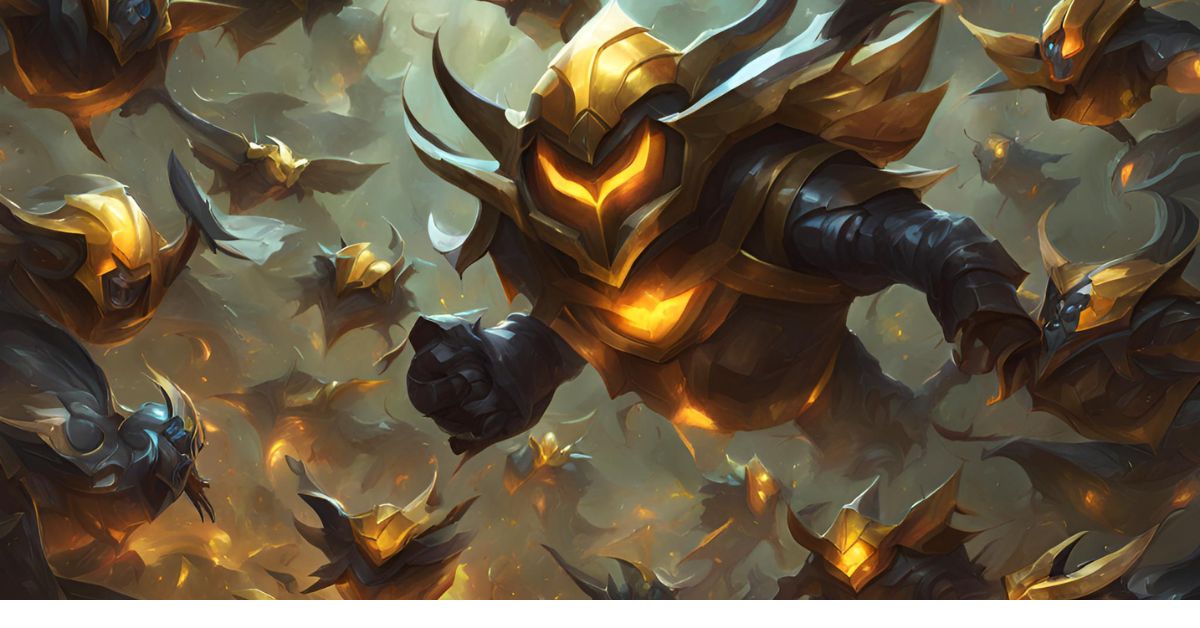Swarm, the latest PvE game mode in League of Legends, is set to go live tomorrow on the main servers. This guide provides an in-depth look at the game mode, offering useful and helpful information for new players. The aim is to ease players into Riot’s new PvE experience, equipping them with basic knowledge and strategies. Read more such articles on Gamingepicneter.com
Table of Contents
ToggleUltimate Guide to Swarm in League of Legends
Swarm is a unique and strategic gameplay mechanic in League of Legends that can significantly influence the outcome of matches. This guide will delve into the concept of Swarm, its significance, and how players can effectively utilize it to gain an advantage over their opponents.
What is Swarm?
Swarm is Riot’s newest PvE bullet heaven game mode, allowing up to four friends to play together. Players level up during gameplay, acquiring new stats and skills. The game ends when either the end boss is defeated or all players are downed. In multiplayer mode, players can resurrect each other, but the resurrection time increases with each death.
Playable Champions
Swarm offers nine playable champions, each with unique abilities and ultimates:
-
Jinx
-
Seraphine
-
Leona
-
Illaoi
-
Braum
-
Yasuo
-
Riven
-
Ahri
-
Xayah
Maps and Difficulties
There are four maps available:
-
Warehouse District
-
The Outskirts
-
Subterranean Lab
-
The Beachhead
Three difficulty levels are available: Easy, Hard, and Extreme. Players must complete all maps in Easy to unlock Hard and then complete all maps in Hard to unlock Extreme. Difficulty also scales with the number of players.
Passive Buffs and Gold Coins

There are 15 passive buffs that can be upgraded with gold coins obtained in-game. These buffs are crucial for clearing higher difficulties.
Gameplay Mechanics
Movement and Combat: Use WASD to move the champion, which auto-aims and fires at the nearest enemy. Toggle auto-aim with the C key.
XP Orbs: Defeated enemies drop XP orbs, which are needed for leveling up. Subsequent levels reward players with health or gold bonuses.
Breakable Crates: Found around the map, these drop items such as gold, health packs, SE mines, and vacuum orbs.
Spires
Spires are quests that reward players with XP, access cards, and augments when completed. There are three types of spires:
Misfortune Boost: Grants a temporary but massive combat boost to the entire team.
Yuumi Quest: Requires players to complete a random mini-game, rewarding them with a permanent combat modifier called augments.
BTH Trials: Applies a negative effect on players but rewards them with gold, XP, and an access card upon completion.
Access Cards
Access cards are obtained by completing spires, slaying elite mobs, or mini-bosses. They grant an additional selection screen with a single offering essential for weapon evolution.
Weapon Evolutions
Swarm features 20 weapons available for evolution. To evolve a weapon, it must reach level five, and the corresponding stat must be achieved.
Augments
Augments are obtained by completing Yuumi Quests. There are 33 augments, some with strong but negative effects. An example of a favored augment is Ramming Runner.
End Game
At the 15-minute mark, the map’s boss arrives. The fight continues until either the boss is defeated or the team is wiped out. After 20 minutes, the difficulty significantly increases, making the game much more challenging.
Crucial Roles and Responsibilities of a Swarm in League of Legends
With the introduction of the Swarm game mode in League of Legends, players are presented with a unique PvE experience that diverges from traditional gameplay. In this mode, players control champions in a bullet-hell style environment, facing waves of enemies and epic bosses. Understanding the key roles and responsibilities of a Swarm in this context is crucial for maximizing effectiveness and ensuring success. Here’s a breakdown of these roles:
1. Champion Selection and Role Specialization
In Swarm, players can choose from nine champions, each with unique abilities and playstyles. Selecting the right champion based on your team’s composition and the challenges of the map is essential. Champions such as Jinx and Seraphine excel in damage output, while others like Leona and Illaoi can provide crowd control and survivability. Understanding each champion’s strengths allows players to fulfill specific roles within the team, such as damage dealer, support, or tank.
2. Map Navigation and Positioning
Players must navigate through four distinct maps—Warehouse District, The Outskirts, Subterranean Lab, and The Beachhead. Effective positioning is crucial in Swarm, as players need to avoid incoming enemy attacks while maximizing their damage output. Utilizing WASD controls for movement, players must stay agile to dodge projectiles and reposition themselves strategically during fights.
3. Objective Completion
Each map in Swarm features specific objectives that must be completed to progress. These include defeating bosses, recruiting new fighters, and unlocking upgrades. Players must communicate and coordinate their efforts to ensure that objectives are met efficiently, as failing to do so can hinder progress and lead to defeat.
4. Leveling Up and Augment Selection
As players defeat enemies, they collect experience points (XP) that allow them to level up. Upon reaching certain levels, players can choose from three Augments that enhance their champion’s abilities or provide stat boosts. Selecting the right Augments based on the current game situation and team needs is vital for maximizing effectiveness in combat.
5. Combat Strategy and Team Coordination
Swarm emphasizes teamwork and coordination during combat encounters. Players must work together to take down waves of enemies and bosses while managing their resources effectively. This includes deciding when to engage, retreat, or use abilities strategically. Effective communication through voice chat or pings can greatly enhance team synergy and lead to successful outcomes.
6. Resource Management
Players earn gold by defeating enemies, which can be used to purchase upgrades that enhance champions’ stats and abilities. Managing resources effectively is crucial, as players need to decide when to invest in upgrades and how to allocate their gold to maximize their team’s potential.
7. Adaptability and Learning
Given the dynamic nature of Swarm, players must be adaptable and willing to learn from each run. Each playthrough can present different challenges and enemy types, requiring players to adjust their strategies and champion builds accordingly. Embracing a growth mindset will improve performance in future games.
The Importance of Swarm in Gameplay
Map Control: Utilizing Swarm tactics allows teams to establish control over key areas of the map. By pushing multiple lanes simultaneously, teams can force opponents to split their resources and attention, making it easier to secure objectives like turrets, dragons, and Baron Nashor.
Team Fights: In team fights, a well-executed Swarm strategy can lead to favorable engagements. By overwhelming the enemy with numbers, teams can quickly eliminate priority targets and gain a significant advantage in the fight.
Psychological Pressure: The threat of a Swarm can create psychological pressure on opponents, forcing them to play defensively. This can lead to mistakes and misplays, which can be capitalized on by the swarming team.
Objective Securing: Swarming can be an effective way to secure objectives. When a team is able to outnumber their opponents, they can quickly take down objectives like turrets and dragons without significant resistance.
How to Execute a Swarm Strategy
Champion Selection: Choose champions that excel in team fights and can deal area-of-effect damage. Champions like Amumu, Malphite, or Orianna can be particularly effective in a Swarm strategy, as they can control the battlefield and deal damage to multiple enemies at once.
Coordination: Effective communication and coordination among team members are crucial for executing a Swarm strategy. Utilize voice chat or pings to signal intentions and ensure that all team members are on the same page.
Timing: Timing is key when executing a Swarm. Look for opportunities when the enemy team is out of position or when they have used key abilities. Engaging when the enemy is at a disadvantage can lead to successful Swarm tactics.
Map Awareness: Keep an eye on the minimap and be aware of enemy movements. If you notice that the enemy team is spread out, it may be an opportune moment to initiate a Swarm on a specific lane or objective.
Utilize Vision: Vision control is critical for executing a successful Swarm. Use wards to keep track of enemy movements and to avoid ambushes. This will allow your team to engage when the enemy is least prepared.
Ultimate Guide to Swarm in League of Legends Conclusion
This guide aims to equip players with the knowledge needed to succeed in Swarm. For more detailed gameplay and strategies, viewers are encouraged to follow the presenter’s Twitch stream. Remember to like, comment, and subscribe for more helpful content.
Swarm is a powerful strategy in League of Legends that can turn the tide of a match when executed correctly. By overwhelming opponents with numbers, teams can gain map control, secure objectives, and create psychological pressure.
Understanding the mechanics of Swarm and how to implement it effectively can give players a significant edge in their matches. Whether you’re a seasoned veteran or a newcomer to the game, mastering the art of Swarm can elevate your gameplay and lead your team to victory.
Ultimate Guide to Swarm in League of Legends FAQs
What is the Swarm game mode in League of Legends?
Swarm is a new PvE game mode where players control champions in a bullet-hell style environment, facing waves of enemies and bosses. It emphasizes cooperative gameplay and allows players to team up with friends or play alone.
How many champions can players choose from in Swarm?
Players can choose from nine champions in Swarm: Jinx, Seraphine, Aurora, Illaoi, Leona, Xayah, Yasuo, Riven, and Briar. Each champion has unique abilities and playstyles.
What are the controls for playing Swarm?
Unlike traditional League of Legends gameplay, Swarm uses WASD keys for movement. Players can also use the mouse to aim and attack, with basic attacks firing automatically when off cooldown.
How do players level up in Swarm?
Players gain experience points (XP) by defeating enemies, which allows them to level up. At levels 3 and 6, players unlock additional abilities and can choose from three Augments to enhance their champion.
What are Augments, and how do they work?
Augments are special upgrades that players can choose at each level up. They enhance abilities, provide passive bonuses, or improve stats, allowing for customization of playstyles during each run.
What objectives must players complete in Swarm?
Players must complete various objectives to progress through the maps, including defeating bosses and collecting XP. Successfully completing objectives unlocks new maps and harder difficulty levels.
How many maps are available in Swarm?
There are four unique maps in Swarm: Warehouse District, The Outskirts, Subterranean Lab, and The Beachhead. Each map features its own aesthetics and challenges.
What happens when players die in Swarm?
If a player dies during a run, it is game over. However, players can unlock permanent stat boosts through repeated play, which will help in future attempts.
Can players play Swarm solo or only in teams?
Players can choose to play Swarm solo or team up with up to three friends. The mode is designed to accommodate both playstyles, allowing for flexible gameplay options.
Is Swarm similar to any other game modes in League of Legends?
Yes, Swarm shares similarities with other PvE modes and bullet-hell games, incorporating elements of survival and cooperative gameplay. It offers a fresh experience distinct from traditional League of Legends mechanics.
